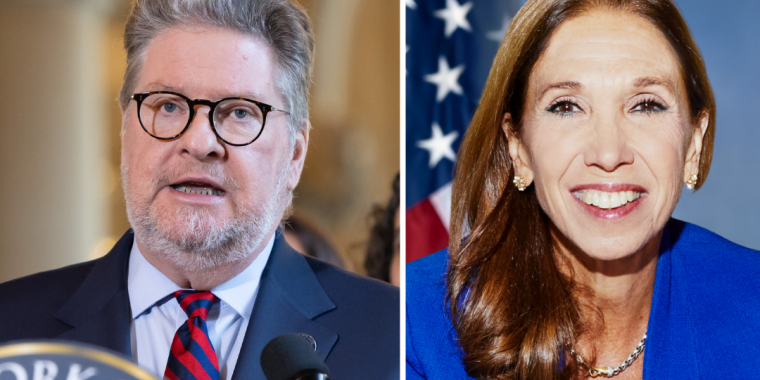
Harckham/Odell Urge All Unvaccinated Putnam County Residents to Get a Measles Vaccine
April 26, 2019

(Mt. Kisco, NY) Senator Pete Harckham (SD40) and Putnam County Executive Maryellen Odell are urging all Putnam County residents to make sure they and their families have been immunized for measles as an outbreak makes its way closer to Putnam County. As of April 19, 2019, there were 226 confirmed cases of measles in New York State outside of New York City. Rockland County has 194 confirmed cases of measles and 329 confirmed cases in Brooklyn and Queens. Westchester recently reported 8 unconfirmed cases in the northern part of the county. The overwhelming majority of the cases had not received the measles vaccine. Measles is an extremely contagious airborne disease that can linger for hours after an infected individual coughs and leaves the room.
“We must keep society safe from diseases that can maim and kill, like measles,” said Harckham. "Parents of unvaccinated children, who do not have a medical exemption, should get the the Measles, Mumps and Rubella (MMR) vaccine as soon as possible for their own safety, as well as the safety of those who are medically unable to be vaccinated. The facts are simple — vaccines save lives.”
"The recent outbreaks across New York State have raised concerns about the need to educate New York residents on the importance of vaccinations for their family and loved ones,” said Odell. “Evidence-based information and facts on vaccination dispels common myths surrounding immunization and demonstrate that vaccines are safe and essential."
Below are contents of a fact sheet on vaccination, that was created alongside the New York State Department of Health:
MYTH / FACT SURROUNDING VACCINATION
Myth 1: Vaccines cause Autism Spectrum Disorder (ASD).
Fact: There is no link between receiving vaccines and developing ASD.
Some people have had concerns that ASD might be linked to the vaccines children receive, but studies have shown that there is no link between receiving vaccines and developing ASD.
In 1998, Andrew Wakefield and a group of 12 co-authors published a case series in the medical journal Lancet, suggesting a link between the MMR vaccine and autism spectrum disorder. This paper received a huge amount of publicity and was followed by a drop in MMR vaccination rates because of some parents’ concerns. However, this “study” turned out to be troubled and its results were deeply suspect:
The “study” was based on only 12 cases.
Its design was unscientific and uncontrolled.
Ten of Wakefield’s 12 co-authors published a retraction of their interpretation of the original data and stated for the record: “No causal link was established between MMR vaccine and autism as the data were insufficient.”
Wakefield failed to disclose that he had been funded by lawyers working for parents who were suing vaccine producers.
Lancet completely retracted the entire paper in February 2010, admitting the paper had multiple errors and that the authors were guilty of ethical violations and scientific misrepresentation.
The British Medical Journal published a series of articles revealing that the authors were guilty of deliberate fraud for financial gain.
In 2015, in the largest-ever study of its kind, researchers found that the MMR vaccine did not increase risk for ASD, even among children already considered at high risk for ASD. In all, the researchers analyzed the health records of 95,727 children, including more than 15,000 children unvaccinated at age 2 and more than 8,000 still unvaccinated at age 5. Nearly 2,000 of these children were considered at risk for autism because they were born into families that already had a child with the disorder.
“Consistent with studies in other populations, we observed no association between MMR vaccination and increased ASD risk,” the authors write. “We also found no evidence that receipt of either one or two doses of MMR vaccination was associated with an increased risk of ASD among children who had older siblings with ASD.”
A 2013 CDC study added to the research showing that vaccines do not cause ASD. The study looked at the number of antigens (substances in vaccines that cause the body’s immune system to produce disease-fighting antibodies) from vaccines during the first two years of life. The results showed that the total amount of antigen from vaccines received was the same between children with ASD and those that did not have ASD.
The single largest study examining autism and the MMR vaccine to date, which followed nearly 660,000 children for over 10 years in Denmark, found no link between autism and vaccination. Dr. Mads Melbye, the study’s author and the director of the Statens Serum Institut in Denmark (Denmark’s CDC) said “It is time to bury the hypothesis that MMR causes autism” after the study’s publication. The study’s truly massive cohort and long period of examination strongly debunks the theory that MMR vaccination increases the risk for autism, triggers autism in susceptible children, or is associated with clustering of autism cases. This study adds significant additional statistical power to the already impressive evidence debunking these theories, and addresses the hypotheses of susceptible subgroups and clustering of cases.
Myth 2: Vaccines cause other disorders.
Fact: Vaccines are not linked with a high incidence of neuropsychiatric or other disorders, and in general, severe side effects from vaccines are quite rare.
At the request of the Department of Health and Human Services, the Institute of Medicine (IOM) issued a report in 2013, addressing the public’s concern with the safety of vaccines and side effects. The report concluded that “upon reviewing stakeholder concerns and scientific literature regarding the entire childhood immunization schedule, the IOM committee finds no evidence that the schedule is unsafe. The committee’s review did not reveal an evidence base suggesting that the U.S. childhood immunization schedule is linked to autoimmune diseases, asthma, hypersensitivity, seizures, child developmental disorders, learning or developmental disorders, or attention deficit or disruptive disorders.”
Even studies that appear to find associations between vaccines and some diseases conclude that the public health benefits far outweigh their findings. For example, a 2017 Yale study titled “Temporal Association of Certain Neuropsychiatric Disorders Following Vaccination of Children and Adolescents: A Pilot Case–Control Study” had the following conclusion:
“This pilot epidemiologic analysis implies that the onset of some neuropsychiatric disorders may be temporally related to prior vaccinations in a subset of individuals. These findings warrant further investigation, but do not prove a causal role of antecedent infections or vaccinations in the pathoetiology of these conditions. Given the modest magnitude of these findings in contrast to the clear public health benefits of the timely administration of vaccines in preventing mortality and morbidity in childhood infectious diseases, we encourage families to maintain vaccination schedules according to CDC guidelines.”
Myth 3: Vaccines contain unsafe toxins.
Fact: All ingredients in vaccines are safe.
The primary ingredients in vaccines are called antigens, these are the substances that cause the body to develop immunity. Antigens are accompanied in the vaccine by other ingredients that ensure the vaccine is as safe and effective as possible. Many of these ingredients would be toxic if taken in large quantities, but in small amounts they help the vaccine work properly. These types of ingredients are listed below.
|
Type of Ingredient |
Examples |
Purpose |
|
Preservatives |
Thimerosal (only in multi-dose vials of flu vaccine) |
To prevent contamination |
|
Adjuvants |
Aluminum salts |
To help stimulate the body’s response to the antigens |
|
Stabilizers |
Sugars, gelatin |
To keep the vaccine potent during transportation and storage |
|
Residual cell culture materials |
Egg protein |
To grow enough of the virus or bacteria to make the vaccine |
|
Residual inactivating ingredients |
Formaldehyde |
To kill viruses or inactivate toxins during the manufacturing process |
|
Residual antibiotics |
Neomycin |
To prevent contamination by bacteria during the vaccine manufacturing process |
Today, the only childhood vaccines used routinely in the United States that contain thimerosal (mercury) are flu vaccines in multi-dose vials. These vials have very tiny amounts of thimerosal as a preservative. This is necessary because each time an individual dose is drawn from a multi-dose vial with a new needle and syringe, there is the potential to contaminate the vial with harmful microbes (toxins). There is no evidence that the small amounts of thimerosal in flu vaccines cause any harm, except for minor reactions like redness and swelling at the injection site. Although no evidence suggests that there are safety concerns with thimerosal, vaccine manufacturers have stopped using it as a precautionary measure. Flu vaccines that do not contain thimerosal are available (in single dose vials).
Myth 4: Vaccines can infect children with the disease they are trying to prevent.
Fact: This could happen, but it is extremely rare.
Depending on the vaccine, about 1% to 5% of children who are vaccinated fail to develop immunity. Children who do not develop immunity from the initial dose are at risk of developing the disease if they are exposed. Sometimes, a second dose will stimulate an immune response in a child who does not respond to the first dose. In the case of the measles vaccine, a single dose protects about 95% of children, but after two doses, almost 100% are immune.
One reason that a child may exhibit symptoms around the time of being vaccinated is that they were exposed to the disease just prior to being vaccinated. Alternatively, a child could fall ill because a vaccine protects against certain strains of a disease, but not all strains. This is common with the flu vaccine as there are many similar viruses. The vaccine may be working, but a child could still become sick with a variation of the disease.
Myth 5: Children who are only exposed to other vaccinated children do not need to be vaccinated themselves.
Fact: Herd immunity only works if enough of the population is vaccinated, and even relatively insular communities can be exposed to infections from outside them.
Herd immunity is a form of immunity that occurs when the vaccination of a significant portion of a population provides a measure of protection for individuals who have not developed immunity. The “Community Immunity Threshold” (CIT) for a given infection is the percentage at which the population is sufficiently immune to prevent the spread of that infection. For measles, an extremely contagious disease, this percentage is at least 92%-94%.
Achieving the CIT percentage and establishing herd immunity is important because there will always be a small portion of the population – infants, pregnant women, elderly, and those with weakened immune systems – that cannot receive vaccines. If too many people don’t vaccinate themselves or their children, they contribute to a collective danger, opening up opportunities for viruses and bacteria introduced from outside to establish themselves and spread. (The current measles outbreak in New York, for example, was introduced by a family that had traveled with an unvaccinated child to Israel, where low vaccination rates have enabled a measles epidemic to occur.) Insufficient vaccination percentages are enabling the current outbreaks of measles happening in certain communities around the country.
Myth 6: It is dangerous for a child to receive multiple vaccinations at the same time.
Fact: Combined vaccines are safe and beneficial.
Giving several vaccines at the same time has no negative effect on a child’s immune system. It reduces discomfort for the child, and it saves time and money. In a 2015 survey of 534 pediatricians and family doctors, only 1% agreed that vaccines should be spread out over time. When parents delay a child’s vaccination schedule, children remain vulnerable to preventable diseases longer. There is also greater risk that future appointments will be delayed and children will miss receiving vaccinations all together due to coordination problems.



